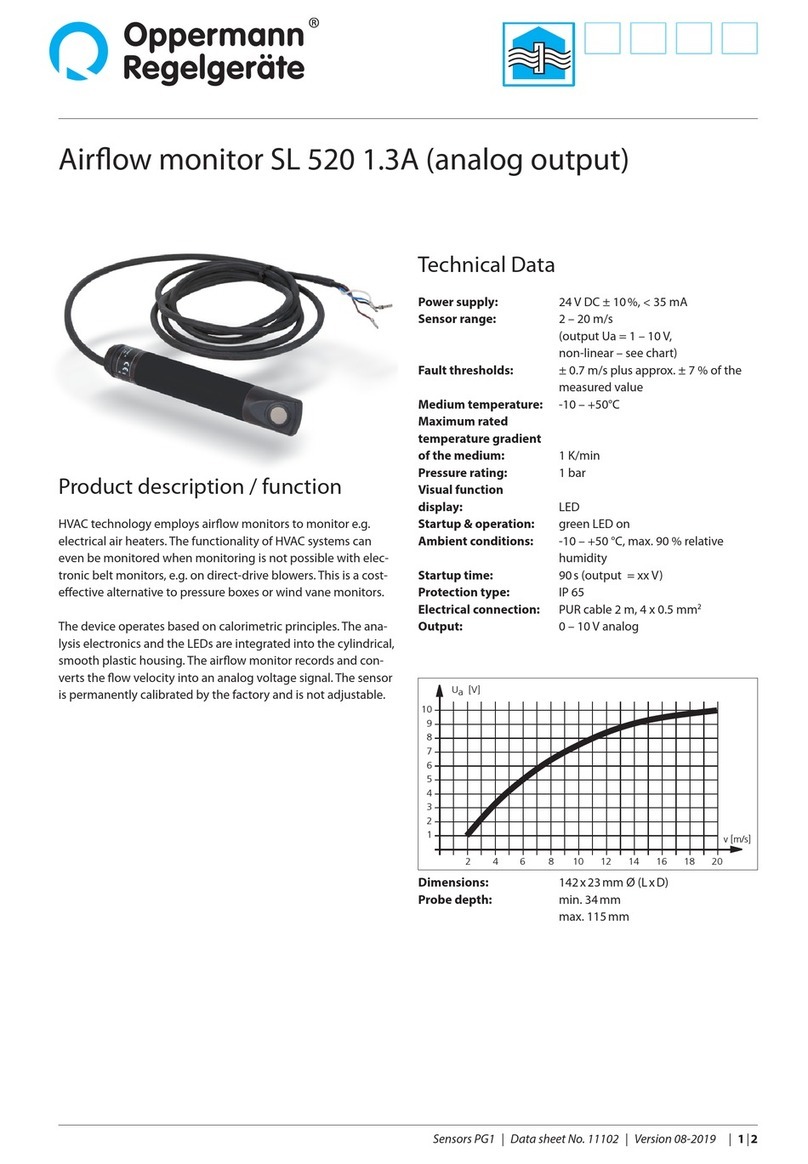
Pressure dierential monitor DD-...-ATEX
2| 4| Sensor ventilation air conditioning PG1 | Data sheet No. 13102 | Version 04-2020
are not liable for printing errors and changes after printing.
Approved uses also include compliance with operating and
installation instructions. We are not liable for losses due to not
approved uses. Unauthorized or inappropriate manipulations
or modications of the device render the operating permit,
the product warranty and warranty claims null and void.
Modifying the equipment is not authorized and can result in
an explosion hazard (ignition). The contents of the EC type
examination certication are binding and must be observed.
Special requirements or variances from standard conditions
are indicated by an„X“ following the EC type examination
certication. Only appropriately qualied sta (iaw. TRBS
1203; qualied person - [„befähigte Person“]) are authorized
to perform installations, startups, and recurring inspections.
Approved uses: Pressure monitors are used in explosive areas
that qualify as zone 1 or 2 (gases and vapors) as well as 21 and
22 (dusts). Adjustable pressure dierential monitors have the
following primary purposes:
• Monitoring positive, negative pressures or pressure
dierentials of air and other non-aggressive, combustible
gases / vapors (e.g. natural gas, biogas)
• Monitoring air lters and blowers, as well as airow in
ventilation ducts, air-conditioning loops, air heaters etc.
• Function is monitored by monitoring airow (e.g for [air]
lters, air and re dampers, blowers, ventilators or closed
system leakage)
• Level monitoring of liquids
Compliance of your application with important explosion
protection specications must be addressed with markings on
the product [G = gas; D = dust; equipment category 1, 2, 3 or
equipment protection level - EPL in the 3 zones. Gas specica-
tions: temperature class (T1…T6), explosion group (A, B, C)].
Dust:specications: explosion group (III A, B: non-conductive;
IIIC: conductive). Dust accumulations must be avoided to
prevent hazardous overheating of surfaces (installation
orientation, covers, cleaning, ...). Steps must be taken to ensure
that all technical and organizational safety measures are
adhered to, and that the function and eectiveness of these are
veried. The operating entity must issue a work permit before
activities of any kind (installation, ...) are performed in explosive
environments. When performing work such as installation,
electrical connections, repairs, or opening the housing,
particular attention is required to ensure that
• no explosive atmosphere exists
• electrical power has not been connected
• inadvertent switching on is not possible
The device may be used in explosive gas as well as in explosive
dust environments. Two separate areas can be connected with
the pressure ports P1 and P2 (areas 1 and 2). Zone 1, 2 or zone
21, 22 can be applied on the pressure ports (areas 1 and 2). The
environment (area 3) can be zone 1, 2 or zone 21, 22.
An associated i device (safety barrier, switching amplier) must
be installed upstream of the secured area. Compliance with
intrinsic safety must then be documented for the entire i
electrical circuit. The power supply specications (P, I, U) of the
barrier must be lower than, and the specications (L, C) must
exceed those of the pressure monitor and the power supply
cable (color: blue).
Electrical specications:
for gas 2G: 30 VDC, 60 mA oder 24 VDC, 100 mA
for dust 2D: 30 VDC, 60 mA, 0.6 W
Capacitance - Ci 0 μF (negligible)
Inductance - Li 0 mH (negligible)
Please also note the following instructions (among others):
• Cables of intrinsically safe and not intrinsically safe electrical
circuits must be routed separately.
• Intrinsically safe and not intrinsically safe electrical circuits
can be routed together for operating voltages below 42 V AC
or 60 V AC. This only applies to safety barriers with galvanic
isolation.
• Intrinsically safe/not intrinsically safe connected components
Zone
Equipment
category
RL 94/9 EG
Equipment
protection
level-EPL 0 1 2
1 G, D Ga, Da Yes Yes Yes
2 G, D Gb, Db No Yes Yes
3 G, D Gc, Dc No No Yes
Area 3 (environment)
Area 1
Area 2
P1 + - P2
Area 1Area 2 Area 3
Environment
Equipment category
Equipment protection level EPL
Zone 1, 2 Zone 1, 2 Zone 1, 2 2G
Gb
Zone 21,
22 Zone 21,
22 Zone 21, 22 2D
Db
























